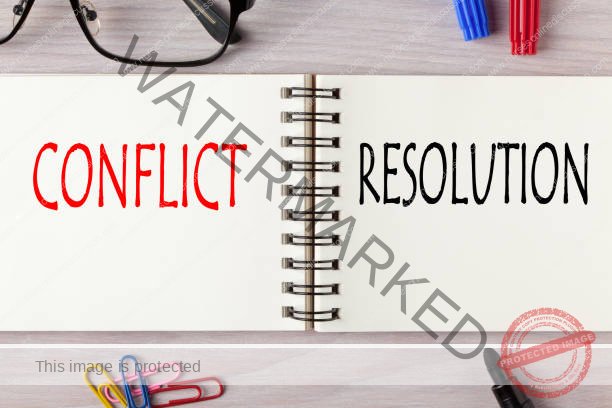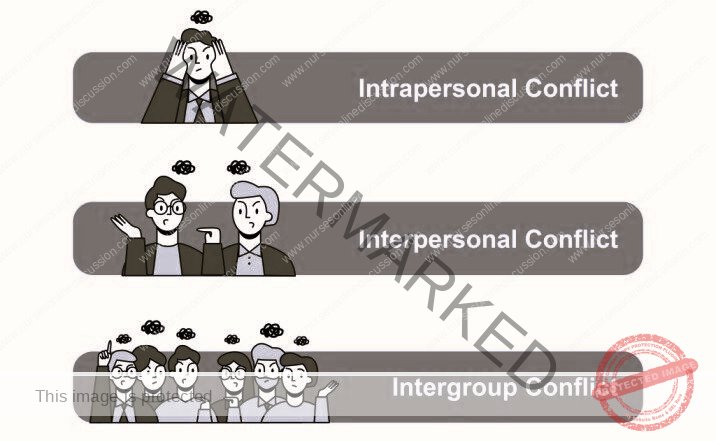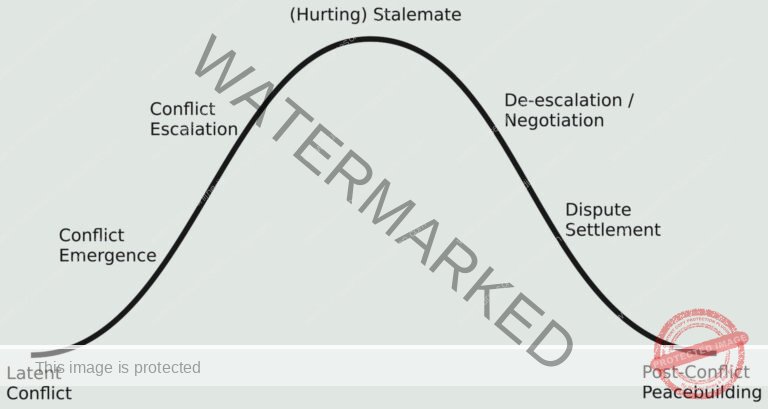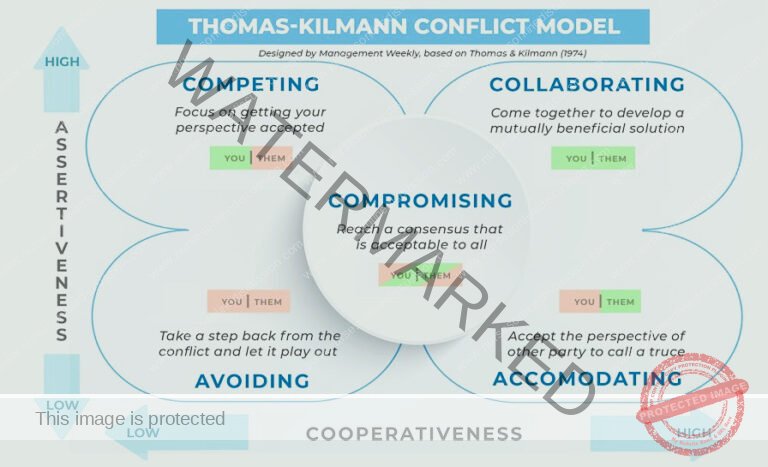Leadership in Healthcare
Subtopic:
Conflict Resolution

Conflict is a communicated struggle between at least two parties who depend on each other.
Conflict arises from any form of unease or dissatisfaction that impacts how well an organization functions.
Conflict is a situation where the desires, needs, aims, or principles of the involved individuals clash with each other.
Conflict can be understood as the result of actual or perceived differences in mutually exclusive objectives, principles, viewpoints, attitudes, convictions, emotions, or actions.
Conflict itself is not a problem. It only becomes problematic if it is not resolved.

Types/Levels of Conflicts
Intrapersonal Conflict (Personal Conflict): This type of conflict occurs within an individual. It arises when we are discontented with ourselves, facing difficult decisions, or feeling frustrated about our progress or achievements. These internal conflicts can often lead to disagreements with others.
Interpersonal Conflict: This is the most common type of conflict, happening between two or more individuals who have different values, objectives, and beliefs. In the workplace, it often stems from natural variations in personality, individual needs, beliefs, or professional ethics. Interestingly, these conflicts can sometimes resolve themselves over time, as prolonged tension can be difficult to maintain for all parties involved.
Social/Intergroup Conflict: This form of conflict occurs between two or more groups of people. These groups could be departments within an organization or even entire organizations.
General Causes of Conflicts
Communication Issues: In healthcare settings, misunderstandings and frustration frequently arise from unclear, infrequent, or ineffective communication. This can manifest as a lack of feedback, misinterpretations, withheld information, or criticism. For example, if a physician doesn’t clearly communicate a patient’s care plan to a nurse, it can lead to confusion and potential mistakes.
Personal Factors: Ego, individual biases, and a lack of empathy can all contribute to disagreements among colleagues in healthcare. For instance, personality clashes or perceived disrespect between team members, like nurses and doctors, can create tension.
Process-Related Factors: Disagreements about the correct way to perform tasks can lead to conflict. For example, two nurses might have differing opinions on the best method for managing a patient’s pain, resulting in arguments and delays in treatment.
Method Preferences: Healthcare professionals might clash due to differing preferences in clinical procedures or patient care approaches. Individuals may believe their method is superior and insist on others following it. For instance, a senior doctor might insist on a specific surgical technique even if more modern and efficient options are available.
Resource Competition: Limited resources, such as staff, budgets, or medical equipment, can breed competition and conflict. For example, two departments vying for the same operating room time can cause delays and frustration for both.
Personality Differences: Variations in personality traits like introversion vs. extroversion, judging vs. perceiving, and differing values, attitudes, needs, expectations, and social styles can lead to misunderstandings and conflict.
Power Dynamics: The desire for control and authority can be a major source of conflict. For example, individuals might compete for promotions, leadership positions, or recognition, and some might misuse their power to control or intimidate others.
Values Conflicts: Differing values can cause conflict when people judge others based on their own beliefs. For instance, ethical dilemmas can lead to disagreements on the right course of action. A doctor’s religious beliefs might lead them to refuse to perform an abortion, causing conflict with a patient requesting the procedure.
Unclear Roles: Vague job roles or responsibilities can cause conflicts among staff regarding task allocation or accountability in patient care.
Inefficient Processes: Poor or outdated processes can lead to frustration and delays.
Lack of Performance Standards: Ambiguous expectations can create confusion and conflict regarding performance evaluations.
Resource Shortages: Insufficient staff, supplies, or funding can worsen conflicts over workload distribution, resource allocation, or access to necessary healthcare services.
Time Pressures: Tight schedules or unrealistic deadlines can cause conflicts among healthcare staff about competing priorities or work-life balance.
Lack of Cooperation: Unwillingness to collaborate or share information can lead to conflict.
Mistrust: A lack of trust among colleagues can hinder effective communication and teamwork, leading to conflicts.
Poorly Defined Goals: Unclear or inconsistent organizational goals can fuel conflicts regarding strategic direction, departmental priorities, or performance expectations.
Skill Deficiencies: Gaps in skills or insufficient training among healthcare professionals can lead to conflicts about competence, proficiency, or training requirements, impacting patient care quality and safety.
Status Threats: Perceived threats to professional standing or authority can trigger conflicts as individuals seek recognition, respect, or influence within the organizational hierarchy.
Unpredictable Policies: Inconsistent or frequently changing hospital policies, procedures, or protocols can create conflicts regarding compliance, adherence, or interpretation, causing confusion and frustration.
Resistance to Change: Conflicts can arise when healthcare professionals resist organizational changes, innovations, or quality improvement initiatives, citing concerns about workflow disruption, job security, or patient care implications.
Stress and Burnout: High levels of work-related stress or burnout can worsen conflicts in healthcare settings, impacting morale and productivity.

STAGES OF CONFLICT
Latent Conflict
Conflict Emergence
Conflict Escalation
Hurting Stalemate
De-escalation
Settlement/ Resolution
Post-conflict peace building and reconciliation.
CONFLICT MANAGEMENT
Conflict management refers to the practice of recognizing and addressing conflict in a logical, equitable, and effective manner.
APPROACHES USED IN CONFLICT MANAGEMENT
Conflict Styles
Competition (win-lose)
Accommodation (lose-win)
Avoidance (lose-lose)
Compromise (lose-lose)
Collaboration (win-win)
Interest-Based Relational Approach
Tool-based conflict resolution process

The conflict resolution styles.
Competition (Win-Lose Approach):
This style involves taking a strong stance and knowing your desired outcome. It operates from a position of authority, which may be derived from your role, rank, expertise, or persuasive skills. This approach can be effective when:
Immediate action is needed in an emergency.
Implementing unpopular decisions.
Standing up against someone trying to exploit a situation unfairly.
However, overuse can leave people feeling defeated, dissatisfied, and resentful, especially in less critical situations.
Collaboration (Win-Win Approach):
This style focuses on meeting the needs of everyone involved. It requires being assertive and cooperative, recognizing the importance of all parties. Collaboration is valuable when:
Diverse perspectives are needed to find the best solution.
There is a history of conflict within the group.
The issue is too critical for a simple compromise.
Compromising (Lose-Lose Approach):
This involves seeking a solution that partially satisfies everyone. It requires everyone to concede something. Compromise is useful when:
The cost of prolonged conflict outweighs the benefits of holding your ground.
Opposing sides are equally powerful and at a standstill.
There are time constraints or deadlines.
Accommodating (Lose-Win Approach):
This style indicates a willingness to prioritize the needs of others over your own. Those who accommodate often know when to yield, but might be persuaded to give up their position even when it’s not necessary. This style is cooperative but less assertive. Accommodation is appropriate when:
The issue is more important to the other party.
Maintaining peace is more valuable than “winning”.
You aim to gain goodwill or reciprocity in the future.
However, it might not always lead to the best outcomes and favors may not always be returned.
Avoidance (Lose-Lose Approach):
This style seeks to sidestep conflict entirely. It involves postponing difficult decisions, accepting default outcomes, and avoiding causing offense. Avoidance can be suitable when:
Achieving victory is impossible.
The issue is minor or insignificant.
Someone else is better positioned to resolve the problem.
However, in many situations, avoidance is often an ineffective and weak strategy.
INTEREST-BASED RELATIONAL (IBR) APPROACH
The Interest-Based Relational Approach (IBRA) is a cooperative method for resolving conflicts that prioritizes building relationships and understanding the fundamental interests of everyone involved. It aims to discover solutions that address everyone’s needs while maintaining and strengthening relationships. It involves:
Prioritizing positive relationships.
Distinguishing between people and problems.
Focusing on the underlying interests being presented.
Actively listening to all perspectives.
Establishing the facts.
Exploring solutions together.
Key reminders:
Ensure confidentiality.
Empathize rather than just sympathize.
Practice active listening.
Maintain fairness.
Focus on the issue, not personal attacks.
Avoid assigning blame.
Identify the central theme.
Reiterate the central theme frequently.
Encourage feedback.
Generate alternative solutions.
Provide positive feedback.
Agree on an action plan.
Using the tool: a conflict resolution process
Step One: Set the Scene
Help everyone understand that the conflict is a shared issue best addressed through discussion and negotiation, not aggression.
Use active listening to ensure you hear and understand the other person’s viewpoint and perception.
Communicate assertively and respectfully, avoiding aggressive language.
Step Two: Gather Information
Ask for the other person’s perspective.
Try to understand their motivations and objectives, and how your actions might be influencing them.
Clearly and concisely identify the core issue.
USING THE TOOL: A CONFLICT RESOLUTION PROCESS
This process involves the following steps:
Set the Scene:
Ensure everyone understands that the conflict is a shared problem that can be best resolved through discussion and negotiation, rather than through aggressive or hostile behavior.
If you are involved, emphasize that you are presenting your perspective on the problem. Employ active listening techniques to ensure you genuinely hear and understand others’ viewpoints and perceptions.
When communicating, adopt a mature and assertive approach, avoiding submissive or aggressive styles.
Gather Information:
Focus on uncovering the underlying interests, needs, and concerns. Ask for the other person’s viewpoint and reassure them that you value their opinion and need their cooperation to resolve the issue.
Attempt to understand their motivations and goals, and consider how your actions might be affecting these.
Agree about the Problem:
This may seem obvious, but differing underlying needs and interests can cause people to perceive problems very differently. It’s crucial to agree on the problem you are trying to solve before you can find a mutually acceptable solution.
Sometimes individuals see different but interconnected problems. If you can’t reach a shared understanding of the problem, then at the very least, ensure you understand how the other person defines the problem.
Get Possible Solutions:
For everyone to feel satisfied with the resolution, it’s helpful if everyone has contributed to generating solutions. Brainstorm a range of possible solutions, and be open to all ideas, even those initially unconsidered.
Negotiate the Solution:
By this point, the conflict might be resolved. Both sides may have a better understanding of each other’s positions, and a mutually acceptable solution might be apparent.
However, you might have also uncovered genuine differences in positions. This is where win-win negotiation techniques become useful to find a solution that, to some extent, satisfies everyone involved.
Three guiding principles here are: Remain Calm, Be Patient, and Show Respect.
How to prevent conflicts
Communicate Effectively:
Ensure your communication is clear and concise. Avoid using technical jargon or terms that team members might not understand.
Be open and honest in your communication. Share your thoughts and feelings transparently and encourage your team members to do the same.
Practice active listening. Pay close attention to what your team members are saying and strive to understand their perspective.
Ask for clarification when needed. If you are unsure about something, don’t hesitate to ask questions.
Provide regular feedback. Inform your team members about their performance and offer constructive feedback when appropriate.
Meet Frequently:
Regular team meetings offer a platform to discuss issues, share updates, foster team relationships.
Encourage open dialogue during meetings and ensure everyone has an opportunity to contribute and speak.
Utilize meetings to brainstorm solutions for problems and conflicts.
Allow Open Expression:
Establish a secure environment where team members feel comfortable expressing their thoughts and feelings.
Promote open communication by being a good listener and demonstrating empathy.
Address concerns promptly and fairly.
Share Objectives:
Confirm that every team member understands the team’s shared goals and objectives.
Communicate how each individual’s role contributes to the overall team goals.
Celebrate team successes together.
Have Detailed Job Descriptions:
Clear job descriptions are essential for preventing conflicts by clearly outlining expectations and responsibilities for each role.
Regularly review job descriptions to ensure they remain current and accurate.
Distribute Tasks Fairly:
Assign tasks based on individual skills and experience.
Be mindful of workload distribution and avoid overburdening team members.
Be open to feedback regarding task assignments and adjust as needed.
Avoid Public Criticism:
Public criticism can be humiliating and damaging to working relationships.
Address concerns in private and with respect.
Focus on the specific behavior, not personal attacks on the individual.
Be Fair and Just:
Treat everyone with respect, irrespective of their position or title.
Apply rules and policies consistently across the team.
Be receptive to feedback and willing to reconsider your own viewpoints.
Be a Role Model:
Lead by setting a positive example and demonstrate the behaviors you expect from your team.
Be positive, respectful, and maintain professionalism in your interactions.
Be willing to acknowledge your mistakes and learn from them.
Get in Touch
(+256) 790 036 252
(+256) 748 324 644
Info@nursesonlinediscussion.com
Kampala ,Uganda
© 2025 Nurses online discussion. All Rights Reserved Design & Developed by Opensigma.co

